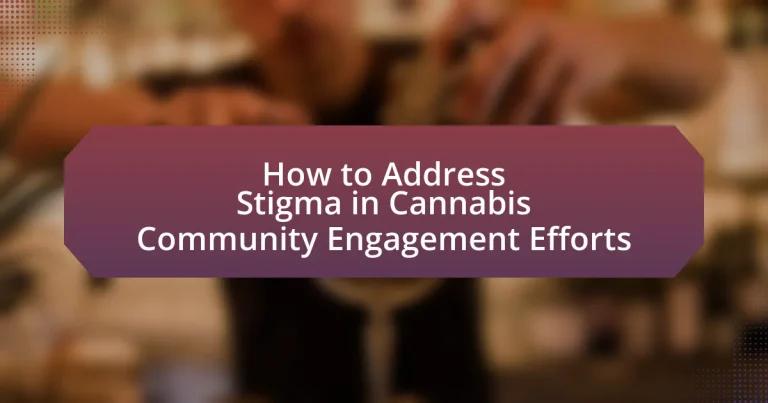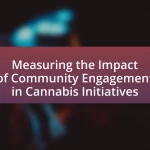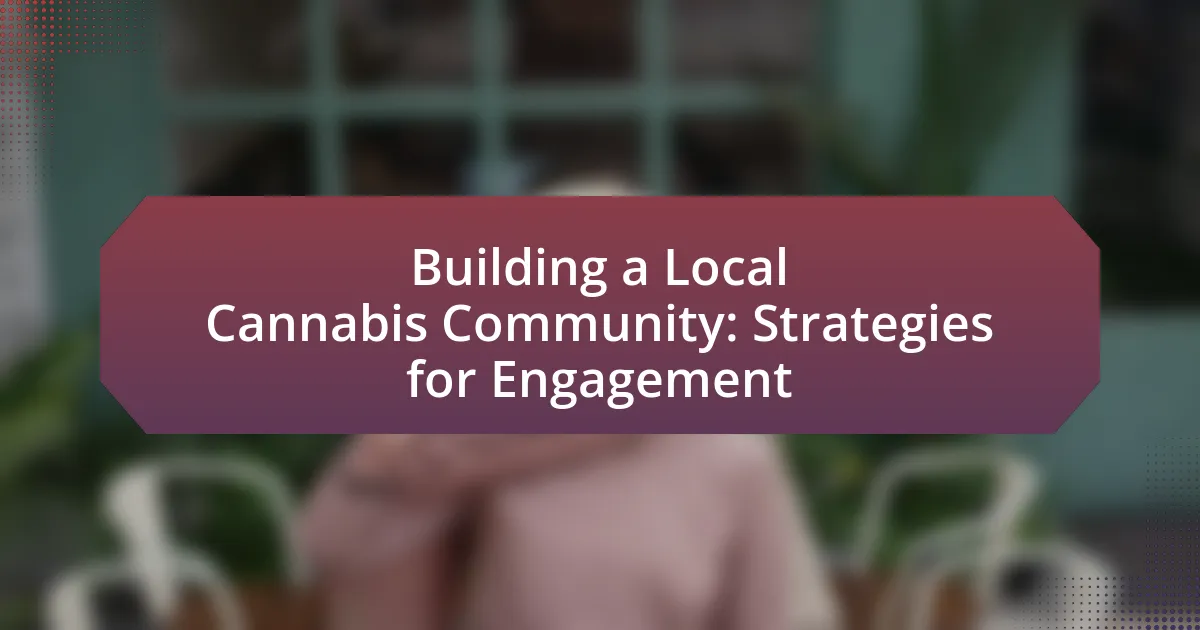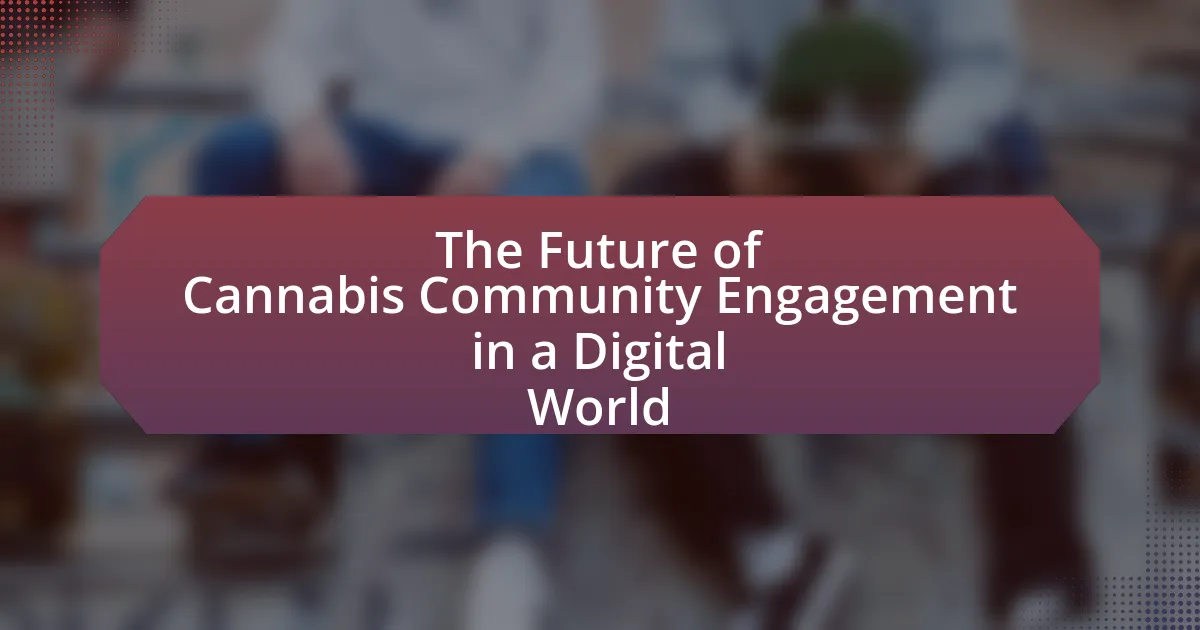The article focuses on addressing stigma within the cannabis community, highlighting the negative perceptions and social disapproval associated with cannabis use. It discusses the detrimental effects of stigma on users and advocates, including discrimination, social isolation, and mental health challenges. The article also examines common misconceptions about cannabis, the importance of education in reducing stigma, and the role of community leaders in fostering inclusive environments. Strategies for enhancing community engagement and promoting understanding through partnerships, personal narratives, and educational initiatives are outlined, emphasizing the need for ongoing support to sustain stigma reduction efforts.
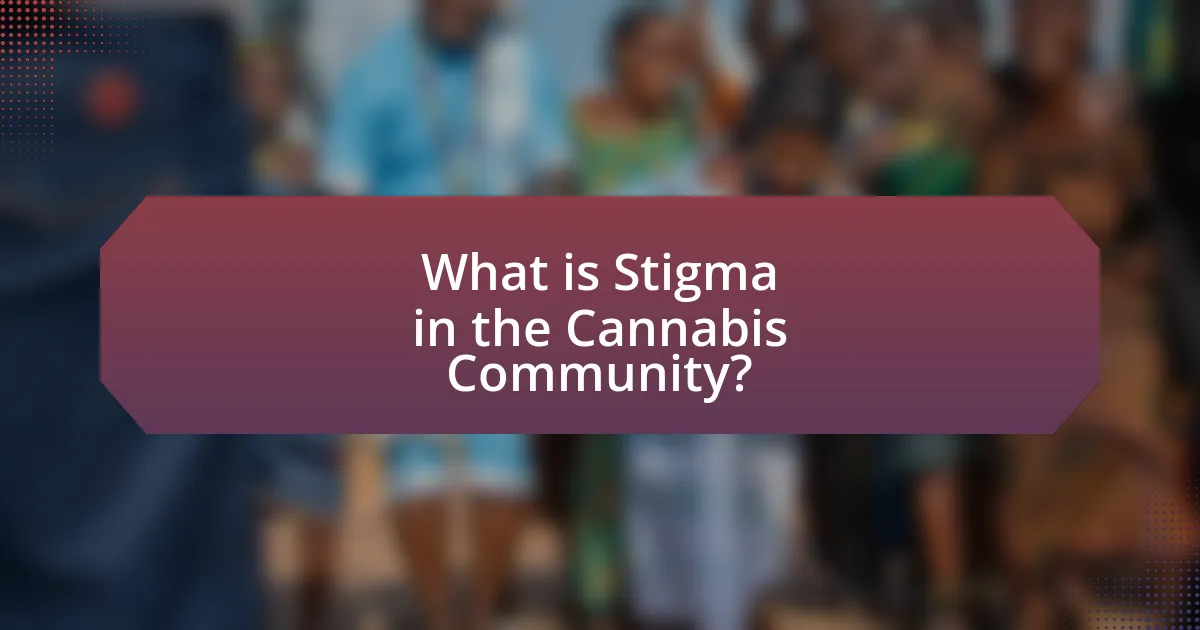
What is Stigma in the Cannabis Community?
Stigma in the cannabis community refers to the negative perceptions and social disapproval associated with cannabis use and its users. This stigma often stems from historical criminalization, misinformation, and cultural biases that portray cannabis as harmful or immoral. Research indicates that stigma can lead to discrimination, social isolation, and reluctance among individuals to openly discuss their cannabis use or seek help for related issues, as evidenced by a study published in the Journal of Psychoactive Drugs, which highlights the impact of stigma on mental health and substance use treatment access.
How does stigma affect cannabis users and advocates?
Stigma negatively impacts cannabis users and advocates by fostering discrimination, social isolation, and mental health challenges. Cannabis users often face judgment and exclusion from social circles, which can lead to feelings of shame and anxiety. Advocates encounter barriers in promoting legalization and responsible use due to public misconceptions, which can hinder policy reform efforts. Research indicates that stigma can result in lower rates of cannabis use among individuals who might benefit from its therapeutic effects, as they fear societal repercussions. For example, a study published in the journal “Psychology of Addictive Behaviors” found that stigma surrounding cannabis use is linked to increased psychological distress among users, further illustrating the detrimental effects of stigma on both individuals and advocacy efforts.
What are the common misconceptions about cannabis use?
Common misconceptions about cannabis use include the belief that it is a gateway drug, that it causes significant cognitive impairment, and that it is universally harmful. Research indicates that while some individuals may progress to harder substances, the majority of cannabis users do not. A study published in the Journal of the American Medical Association found no conclusive evidence supporting the gateway theory. Additionally, while cannabis can affect short-term memory, studies show that these effects are often temporary and do not lead to long-term cognitive decline in most users. Furthermore, the National Academies of Sciences, Engineering, and Medicine reported that cannabis has therapeutic benefits for certain medical conditions, countering the notion that it is entirely harmful.
How does stigma impact mental health within the community?
Stigma negatively impacts mental health within the community by fostering feelings of shame, isolation, and fear among individuals with mental health issues. This social stigma can lead to reduced access to care, as individuals may avoid seeking help due to concerns about judgment or discrimination. Research indicates that stigma is associated with higher levels of psychological distress and lower self-esteem, which can exacerbate existing mental health conditions. For instance, a study published in the journal “Psychological Medicine” found that individuals who experience stigma are more likely to report symptoms of anxiety and depression, highlighting the detrimental effects of stigma on mental well-being.
Why is addressing stigma important for community engagement?
Addressing stigma is crucial for community engagement because it fosters inclusivity and encourages participation from diverse groups. When stigma surrounding cannabis use is reduced, individuals feel safer and more accepted, leading to increased collaboration and dialogue within the community. Research indicates that stigma can create barriers to accessing services and participating in community initiatives, as seen in studies showing that marginalized groups often avoid engagement due to fear of judgment or discrimination. By actively addressing stigma, communities can enhance trust, promote understanding, and ultimately create a more supportive environment for all members.
What are the potential benefits of reducing stigma?
Reducing stigma can lead to improved mental health outcomes and increased access to resources for individuals affected by stigmatized conditions. When stigma is diminished, individuals are more likely to seek help and support, resulting in better overall well-being. Research indicates that communities with lower stigma levels experience higher rates of treatment adherence and recovery, as evidenced by a study published in the Journal of Health Psychology, which found that stigma reduction initiatives significantly increased the likelihood of individuals engaging in mental health services. Furthermore, reducing stigma fosters a more inclusive environment, encouraging open discussions and education about cannabis use, which can enhance community engagement and support.
How can stigma hinder cannabis policy reform?
Stigma can hinder cannabis policy reform by perpetuating negative perceptions and misinformation about cannabis use, which influences public opinion and legislative action. This negative perception often leads to resistance from policymakers who fear backlash from constituents, resulting in stalled or regressive policies. For instance, a 2021 survey by the Pew Research Center found that 60% of Americans support cannabis legalization, yet stigma surrounding its use can still sway local governments to maintain prohibitionist policies. Additionally, stigma can discourage individuals from advocating for reform, limiting grassroots movements that are essential for driving change.
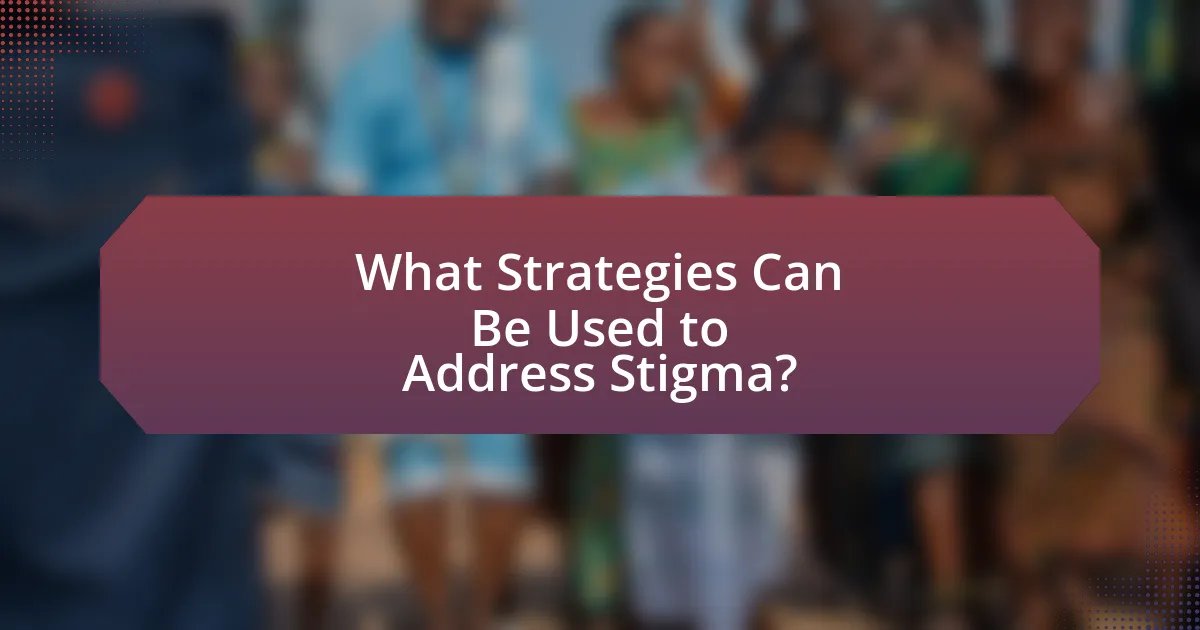
What Strategies Can Be Used to Address Stigma?
To address stigma in cannabis community engagement efforts, strategies such as education, advocacy, and community involvement can be employed. Education initiatives that provide accurate information about cannabis can dispel myths and misconceptions, as evidenced by studies showing that informed individuals are less likely to hold stigmatizing views. Advocacy efforts that promote policy changes can help normalize cannabis use and reduce stigma, supported by data indicating that legalizing cannabis correlates with decreased stigma in communities. Additionally, fostering community involvement through events and discussions can create safe spaces for dialogue, which has been shown to enhance understanding and acceptance among diverse groups.
How can education play a role in reducing stigma?
Education can significantly reduce stigma by providing accurate information and fostering understanding about cannabis use and its effects. By educating individuals about the science behind cannabis, including its medicinal benefits and potential risks, misconceptions can be challenged and corrected. Research indicates that informed communities are less likely to hold negative stereotypes; for instance, a study published in the Journal of Drug Issues found that educational interventions led to a 30% decrease in stigma-related attitudes towards cannabis users. This demonstrates that targeted educational programs can effectively shift perceptions and promote acceptance within the cannabis community.
What types of educational programs are most effective?
Evidence-based educational programs that incorporate interactive learning and community involvement are the most effective. Programs that utilize hands-on activities, peer-led discussions, and real-life scenarios have shown to enhance understanding and retention of information. For instance, a study published in the Journal of Drug Education found that interactive educational interventions significantly improved knowledge and attitudes towards cannabis use among participants, demonstrating a 30% increase in knowledge retention compared to traditional lecture-based formats. Additionally, programs that engage community members in the design and delivery of content foster a sense of ownership and relevance, further increasing their effectiveness in addressing stigma.
How can personal stories help change perceptions?
Personal stories can change perceptions by humanizing experiences and fostering empathy among audiences. When individuals share their personal narratives related to cannabis use, they provide relatable contexts that challenge stereotypes and misconceptions. Research indicates that storytelling can significantly influence attitudes; for instance, a study published in the Journal of Health Communication found that narratives can effectively alter beliefs and increase understanding about stigmatized topics, including cannabis. By presenting real-life experiences, personal stories create emotional connections that encourage listeners to reconsider their preconceived notions and biases.
What role do community leaders play in stigma reduction?
Community leaders play a crucial role in stigma reduction by fostering open dialogue and promoting education about cannabis use. They serve as trusted figures within their communities, helping to dispel myths and misconceptions surrounding cannabis through informed discussions and outreach initiatives. Research indicates that community leaders can effectively influence public perceptions and attitudes, as seen in studies where community-led campaigns resulted in increased acceptance and understanding of cannabis-related issues. By leveraging their influence, community leaders can create supportive environments that encourage individuals to share their experiences and seek help without fear of judgment, ultimately contributing to a decrease in stigma associated with cannabis use.
How can leaders foster inclusive environments?
Leaders can foster inclusive environments by actively promoting diversity and ensuring equitable participation among all community members. This can be achieved through implementing policies that prioritize representation, providing training on unconscious bias, and creating safe spaces for open dialogue. Research indicates that organizations with diverse leadership teams are 35% more likely to outperform their peers, highlighting the importance of inclusivity in driving success. By valuing diverse perspectives, leaders can enhance collaboration and innovation, ultimately benefiting community engagement efforts, particularly in addressing stigma within the cannabis community.
What initiatives can leaders implement to promote understanding?
Leaders can implement educational programs and community workshops to promote understanding of cannabis-related issues. These initiatives can provide accurate information about cannabis, its uses, and its effects, thereby reducing stigma. Research indicates that informed communities are more likely to engage positively with cannabis-related topics, as seen in studies showing that educational interventions can significantly change perceptions and reduce stigma (e.g., the National Institute on Drug Abuse highlights the importance of education in shaping public attitudes). By fostering open dialogues and providing resources, leaders can create an environment conducive to understanding and acceptance.
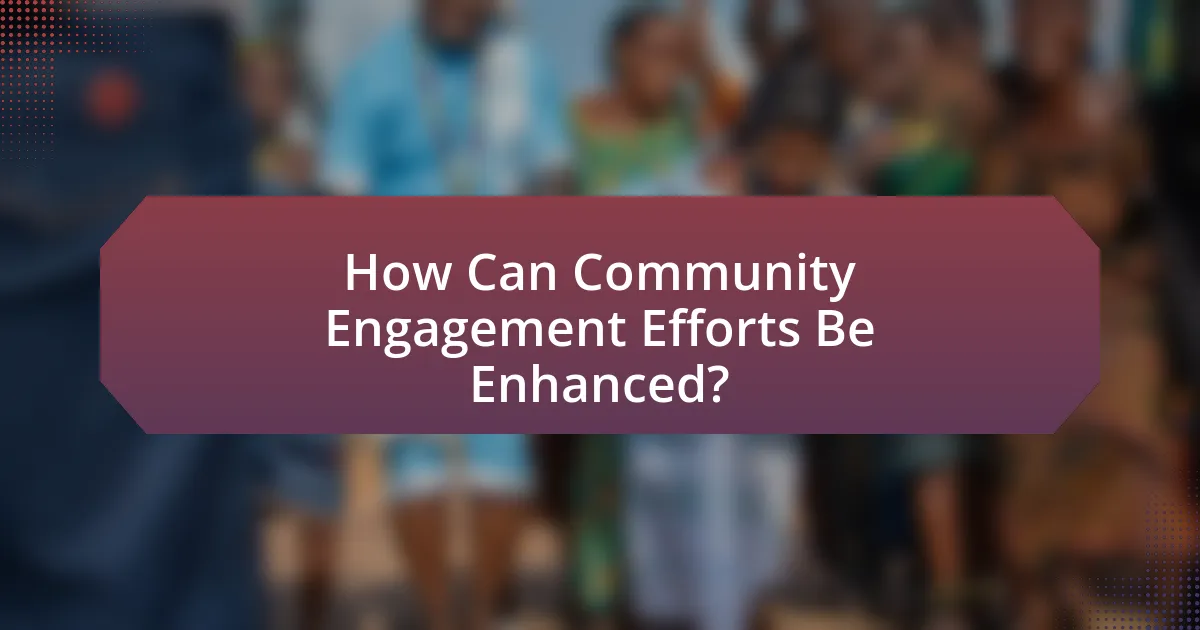
How Can Community Engagement Efforts Be Enhanced?
Community engagement efforts can be enhanced by fostering inclusive dialogue and collaboration among diverse stakeholders. Engaging local organizations, community leaders, and residents in the planning and implementation of initiatives ensures that the efforts are relevant and culturally sensitive. Research indicates that communities with strong partnerships between local governments and residents experience higher levels of trust and participation, which can lead to more effective engagement strategies. For example, a study by the National Civic League found that cities with active community engagement programs saw a 30% increase in citizen participation in local governance. This demonstrates that enhancing community engagement requires a commitment to inclusivity and collaboration.
What are effective methods for engaging the community?
Effective methods for engaging the community include organizing educational workshops, facilitating open forums, and utilizing social media platforms. Educational workshops provide valuable information about cannabis, helping to dispel myths and reduce stigma. Open forums encourage dialogue between community members and experts, fostering understanding and trust. Social media platforms allow for broad outreach and engagement, enabling real-time interaction and feedback. Research indicates that communities that actively participate in discussions and educational initiatives experience a significant reduction in stigma associated with cannabis use, as evidenced by studies conducted by the National Institute on Drug Abuse, which highlight the importance of informed community engagement in changing perceptions.
How can social media be utilized for stigma reduction?
Social media can be utilized for stigma reduction by fostering open dialogue and sharing personal stories that humanize individuals affected by stigma. Platforms like Facebook, Twitter, and Instagram allow users to disseminate information, challenge misconceptions, and promote positive narratives about cannabis use. Research indicates that social media campaigns, such as the #WeedAreThePeople initiative, have successfully raised awareness and reduced stigma by highlighting the benefits of cannabis for medical and recreational purposes. By engaging communities through relatable content and supportive networks, social media serves as a powerful tool in reshaping perceptions and encouraging acceptance.
What community events can promote positive cannabis narratives?
Community events such as educational workshops, health fairs, and cannabis expos can promote positive cannabis narratives. Educational workshops provide accurate information about cannabis benefits and responsible use, helping to dispel myths. Health fairs can include discussions on medical cannabis, showcasing its therapeutic potential, which is supported by research indicating its efficacy in treating conditions like chronic pain and epilepsy. Cannabis expos allow for networking and sharing success stories from users and businesses, fostering a sense of community and normalizing cannabis culture. These events collectively contribute to a more informed public perception and reduce stigma associated with cannabis use.
How can partnerships strengthen community engagement?
Partnerships can strengthen community engagement by leveraging diverse resources and expertise to foster trust and collaboration among community members. When organizations collaborate, they can combine their strengths, such as outreach capabilities and local knowledge, which enhances the effectiveness of engagement efforts. For instance, a study by the National Institute of Health found that community-based partnerships in health initiatives led to increased participation rates and improved outcomes, demonstrating that collective action can address stigma and promote inclusivity. By working together, partners can also amplify their voices, reach wider audiences, and create a more supportive environment for community members, particularly in sensitive areas like cannabis-related initiatives.
What organizations should cannabis advocates collaborate with?
Cannabis advocates should collaborate with organizations such as the National Organization for the Reform of Marijuana Laws (NORML), the Marijuana Policy Project (MPP), and the Drug Policy Alliance (DPA). These organizations focus on reforming cannabis laws, advocating for policy changes, and reducing stigma associated with cannabis use. For instance, NORML has been instrumental in legislative efforts across various states, while MPP works on public education campaigns that aim to shift perceptions about cannabis. The DPA emphasizes harm reduction and social justice, providing a comprehensive approach to addressing stigma in cannabis community engagement efforts.
How can cross-sector partnerships enhance outreach efforts?
Cross-sector partnerships can enhance outreach efforts by leveraging diverse resources, expertise, and networks to reach broader audiences. These collaborations allow organizations from different sectors, such as public health, non-profits, and private businesses, to combine their strengths, resulting in more effective communication strategies and increased credibility. For instance, a partnership between a cannabis advocacy group and a public health organization can provide accurate information about cannabis use, thereby reducing stigma and misinformation. Research shows that multi-sector collaborations can improve community engagement outcomes, as evidenced by the success of initiatives like the National Collaborative on Childhood Obesity Research, which utilized cross-sector partnerships to effectively disseminate health information.
What are best practices for addressing stigma in cannabis community engagement?
Best practices for addressing stigma in cannabis community engagement include fostering open dialogue, providing education, and promoting positive narratives. Open dialogue allows community members to share experiences and concerns, which can reduce misconceptions. Education initiatives, such as workshops and informational sessions, help dispel myths about cannabis use and its effects, leading to informed discussions. Promoting positive narratives through success stories and testimonials from individuals who have benefited from cannabis can shift perceptions and highlight its potential benefits. These strategies are supported by research indicating that stigma can be reduced through increased awareness and understanding, as demonstrated in studies on public attitudes toward cannabis.
How can feedback from the community shape engagement strategies?
Feedback from the community can significantly shape engagement strategies by providing insights into the needs, preferences, and concerns of community members. This direct input allows organizations to tailor their approaches, ensuring that engagement efforts resonate with the audience. For instance, a study by the National Institute on Drug Abuse found that community-driven initiatives in public health are more effective when they incorporate local feedback, leading to higher participation rates and improved outcomes. By actively soliciting and integrating community feedback, organizations can foster trust, reduce stigma, and enhance the overall effectiveness of their engagement strategies in the cannabis sector.
What ongoing support is necessary for sustained stigma reduction?
Ongoing support necessary for sustained stigma reduction includes continuous education, community engagement, and policy advocacy. Continuous education helps to inform the public about the benefits and realities of cannabis use, countering misinformation and stereotypes. Community engagement fosters open dialogue and personal connections, which can humanize individuals within the cannabis community and reduce prejudice. Policy advocacy is essential to create a supportive legal framework that promotes acceptance and protects the rights of cannabis users. Research indicates that these strategies collectively contribute to long-term changes in public perception and attitudes towards cannabis, as evidenced by studies showing that informed communities exhibit lower levels of stigma (e.g., the National Institute on Drug Abuse reports that education reduces stigma associated with substance use).
